Physical Address
304 North Cardinal St.
Dorchester Center, MA 02124
Non–small cell lung cancer (NSCLC) is the second most common cancer diagnosed in the United States and the leading cause of cancer-related mortality, with an estimated 221,200 new cases and 158,040 deaths anticipated in 2015. Lung cancer was the leading cause of cancer death among men in 2012. Among women, lung cancer was the leading cause of cancer death in more developed countries and the second leading cause of cancer death in less developed countries. Globally, the overall lifetime risk of lung cancer is about 1 in 13 for men and 1 in 16 for women.
Lung cancer is strongly associated with tobacco smoking, and approximately 90% of lung cancers are considered attributable to smoking. However, lung cancer rates in Chinese women (20.4 cases per 100,000 women) were higher than rates among women in some European countries despite a lower prevalence of smoking. This is thought to reflect indoor air pollution from unventilated biomass-fueled stoves and cooking fumes. Other known risk factors for lung cancer include exposure to occupational and environmental carcinogens such as asbestos, arsenic, radon, and polycyclic aromatic hydrocarbons. Recently, outdoor pollution has also been determined to cause lung cancer. More than one-half of the lung cancer deaths attributable to ambient fine particles were projected to have been in East Asian countries.
In recent years there have been significant developments in lung cancer classification, molecular pathology, and therapy. Lung cancer is one of the most challenging cancers to treat, and the standard therapy includes surgical resection, platinum-based chemotherapy, and radiation therapy alone or in combination. Unfortunately, the prognosis of patients with lung cancer (5-year overall survival rates of 15%) has not changed dramatically in the past 30 years using these conventional therapeutic approaches. Although therapeutic improvements seen in the clinical trials for lung cancer are modest, the discovery of the first small-molecule inhibitor in lung cancer in the past decade brought hope that an increasing number of agents will be available in the near future to reduce suffering and mortality in patients with this devastating disease. Treatment of cancers in general, and lung cancer in particular, with small-molecule inhibitors is defined as targeted therapy.
In 2015 the World Health Organization (WHO) Classification of Tumors of the Lung, Pleura, Thymus and Mediastinum was published, updating previous classifications and revisions since the 2004 classification. The recent tumor classification system ( Table 26.1 ) addresses the inadequacies of the 2004 classification and provides the foundation for tumor diagnosis and patient therapy and a critical basis for epidemiologic, molecular, and clinical studies.
| Adenocarcinoma |
|---|
|
| Squamous cell carcinoma |
|
| Neuroendocrine tumors |
|
| Large cell carcinoma |
| Adenosquamous carcinoma |
| Pleomorphic carcinoma |
| Spindle cell carcinoma |
| Giant cell carcinoma |
| Carcinosarcoma |
| Pulmonary blastoma |
| Other and unclassified carcinomas |
|
| Salivary gland-type tumors |
|
| Papillomas |
|
| Adenomas |
|
The scope for this chapter is the following lung cancers: adenocarcinoma, squamous carcinoma, adenosquamous carcinoma, large cell carcinoma, and pleomorphic carcinoma.
Malignant epithelial tumor with glandular differentiation, mucin production, or pneumocyte marker expression (WHO, 2015)
More than 40% of lung cancers
Varied from asymptomatic to chest pain, cough, and systemic symptoms
Association with tobacco smoking is less marked than other forms of lung carcinoma and type most observed in nonsmokers
Focal nodular and peripheral masses, or pneumonic picture
Diffuse pleurotropic growth recognized
Peripheral mass, lobulated, mucoid, associated with scar
Lepidic, acinar, papillary, micropapillary, and solid with mucin production
Adenocarcinoma variants: mucinous, colloid, fetal, and enteric
Most are CK7, TTF-1, Napsin A, and surfactant apoprotein positive
Metastatic adenocarcinoma
Malignant mesothelioma, epithelioid subtype
Metastatic epithelioid neoplasms: amelanotic melanoma, germ cell neoplasia
Adenocarcinoma is the most frequent cell type of lung cancer, accounting for over 50% of cancers in most recent series. Adenocarcinoma is the most frequent type in persons who have never smoked. The clinical symptomatology and physical signs are recognized to be diverse relating to local/direct effects, metastatic disease, paraneoplastic syndromes, endocrinopathies, hematologic dysfunction, and generic systemic features.
To date, most validated and investigational predictive biomarkers have been identified in adenocarcinoma compared with other cell types and a new subtype classification of adenocarcinoma has been proposed by the International Association for the Study of Lung Cancer, American Thoracic Society, and the European Respiratory Society that takes into account the molecular pathology of these tumors. The most important changes since the 2004 classification system are (1) eliminate bronchioloalveolar carcinoma (BAC), (2) define the term adenocarcinoma in situ (AIS), (3) define the term minimally invasive adenocarcinoma (MIA), (4) revive the term lepidic, (5) promote comprehensive histologic subtyping, (6) emphasize and introduce the term micropapillary carcinoma, (7) detach the term mucinous adenocarcinoma, and (8) discourage use of the term NSCLC and subclassify the tumors in as much detail as possible.
The current classification of lung adenocarcinoma by the WHO recognizes several distinct morphologic subtypes of adenocarcinoma: papillary, micropapillary, acinar, solid, and lepidic. The majority of lung adenocarcinomas exhibit combinations of morphologic patterns. Although the biologic basis for the histologic subtypes remains an area of active investigation, there is evidence that some subtypes may be associated with specific molecular alterations or a better outcome.
Adenocarcinomas of the lung have a varied appearance on chest imaging studies. They may present as focal masses, nodular patterns, and pneumonic or diffuse forms. They are more commonly peripheral lesions. Pleural thickening is common, and some may present with diffuse pleurotropic or mesothelioma-type imaging.
Grossly, adenocarcinoma typically has an irregularly lobulated configuration, with a gray-white cut appearance ( Fig. 26.1 ). Because they are predominantly peripheral parenchymal masses, adenocarcinomas, in contrast to squamous cell carcinoma (SCC) of the lung, are rarely associated with large airways. Anthracotic pigment is commonly entrapped in the tumor mass. Gross necrosis is uncommon except in larger masses. They may be found in association with fibrosis and pleural puckering. The penetration of the pleura is important in tumor staging and may require additional studies such as elastic stains for definitive evaluation.
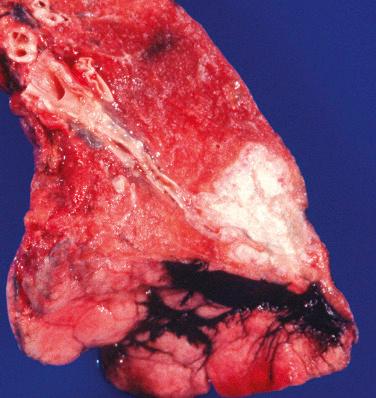
AIS, formerly BAC, is a preinvasive lesion and defined as growth of neoplastic cells restricted to along alveolar walls and lacking stromal invasion, known as a lepidic pattern, that is <3 cm in size ( Fig. 26.2 ). It is an important subtype of pulmonary adenocarcinoma. This cancer has received increasing attention in recent years due to its increasing incidence and rate of sensitivity to epidermal growth factor–tyrosine kinase (EGFR) inhibitors. AIS is a primary lung tumor with a peripheral location, well-differentiated cytology, lepidic growth pattern, and a tendency for both aerogenous and lymphatic spread. The key feature is preservation of the underlying architecture of the lung with no invasion. Virtually all cases of AIS are the nonmucinous type.
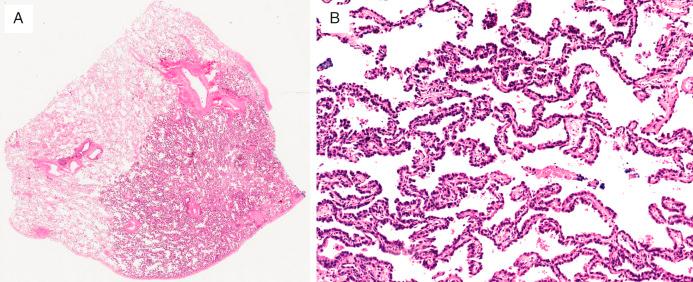
MIA was introduced to define patients with a near 100% 5-year disease-free survival. It is defined as a lepidic predominant tumor measuring 3 cm or less that has an invasive component of 5 mm or less ( Fig. 26.3 ). MIA is characterized by a combination of ground-glass opacity (GGO) and a central solid opacity on imaging studies, with the solid component measuring 5 mm or less. These tumors can have nonmucinous cells ( Fig. 26.2 ) and mucinous cells ( Fig. 26.4 ) growing in a lepidic pattern. Nonmucinous MIA is more common than mucinous MIA and most often appears as a GGO. Mucinous MIA appears radiologically as a solid or part-solid nodule. Pure lepidic mucinous adenocarcinomas that are >3 cm (formerly mucinous BAC) are now designated as mucinous adenocarcinoma (see later).
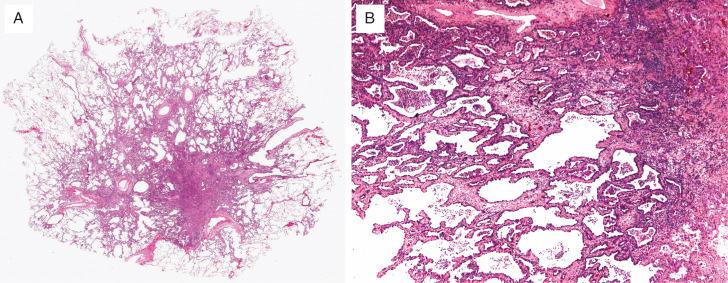
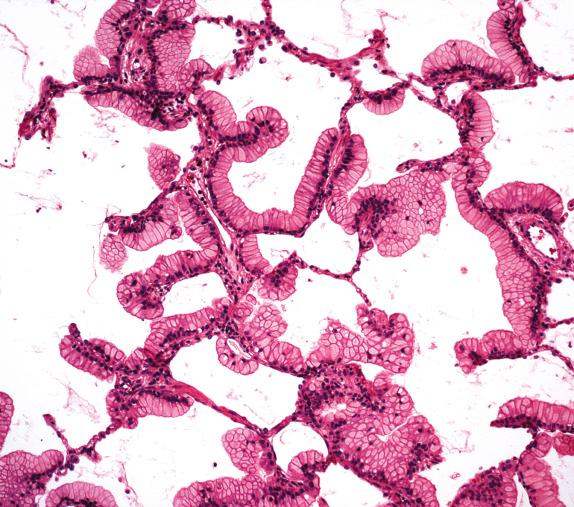
Adenocarcinoma is defined as carcinoma with gland formation, mucin production, or pneumocyte marker expression. Overtly invasive adenocarcinomas are classified according to the predominant subtype after the use of comprehensive histologic subtyping to estimate the percentages of the various components in a semiquantitative fashion in 5% to 10% increments. The adenocarcinoma patterns are lepidic, acinar, papillary, micropapillary, and solid. The invasive adenocarcinoma variants are mucinous adenocarcinoma, colloid, fetal, and enteric.
The term lepidic-predominant adenocarcinoma consists of mixed subtype tumors containing a predominant lepidic growth pattern of type II pneumocytes and/or Clara cells (formerly known as nonmucinous BAC ) that have an invasive component >5 mm. The tumor typically has a tan/gray area of consolidation that may mimic pneumonia with satellite nodules. ( Fig. 26.5A and B ). Lepidic-predominant mucinous adenocarcinomas with other subtypes of adenocarcinoma that are >3 cm are designated as mucinous adenocarcinoma.
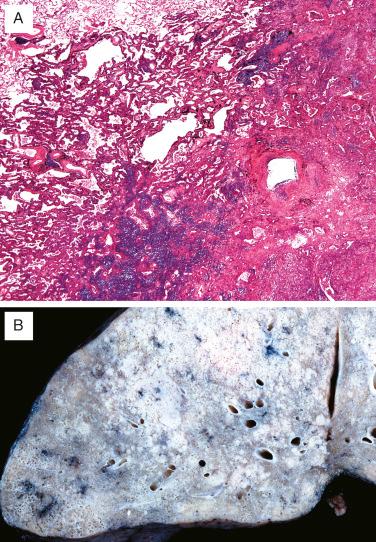
The acinar-predominant adenocarcinoma consists of malignant epithelial cells forming varying sized glands and tubules ( Fig. 26.6 ). The papillary-predominant adenocarcinoma shows complex branching fibrovascular cores lined by malignant epithelial cells ( Fig. 26.7 ). A micropapillary-predominant subtype is added because it has been recognized as a poor prognostic category. It has florid small papillary configurations that lack fibrovascular cores ( Fig. 26.8 ). The solid mucin-predominant adenocarcinoma shows sheets or nests of tumor cells with polygonal and large vesicular nuclei, prominent nucleoli, and moderately abundant cytoplasm. Intracytoplasmic mucin may be demonstrated by periodic acid–Schiff stain with diastase, mucicarmine, and/or Alcian blue stain ( Fig. 26.9 ). Signet ring and clear cell carcinoma subtypes are now recorded as cytologic features (rather than subtypes of adenocarcinoma) whenever present, with a comment about the percentage identified.
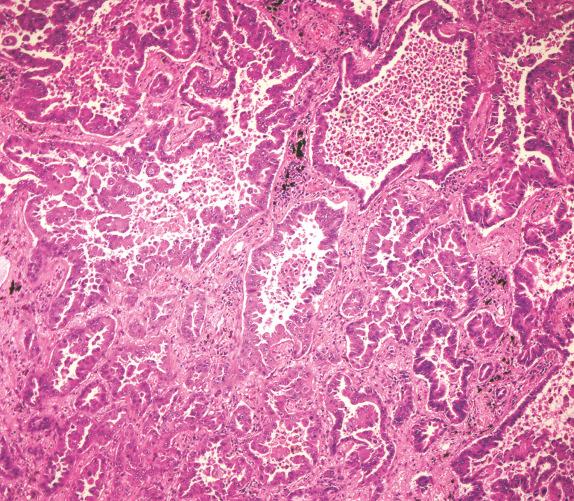

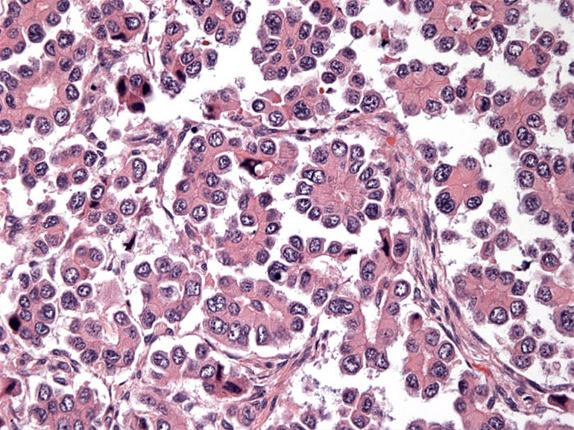

The mucinous adenocarcinomas are often poorly defined and multicentric, comprising columnar cells with abundant intracellular mucin production. This mucinous variant may be observed with any of the aforementioned growth patterns (lepidic, acinar, papillary, and micropapillary) aside from the solid type. The most common pattern is lepidic, although extensive sampling is required to assess potential areas of invasion. Colloid variant adenocarcinoma comprises adenocarcinoma with abundant extracellular mucin pools. Recent studies have shown that mucinous differentiation associated with colloid adenocarcinomas correlates with absence of EGFR mutation and the presence of KRAS mutation in lung adenocarcinomas with lepidic features. Fetal variant adenocarcinoma shows malignant glands with endometrioid morphology and distinct intracellular glycogenization with squamous morule formation in loose myxoid stroma. There are low- and high-grade forms dependent on necrosis and nuclear atypia. Enteric variant adenocarcinoma shows >50% tumor resemblance to intestinal adenocarcinoma and is a potential pitfall in differentiation of metastatic colorectal adenocarcinoma. It is not uncommon for adenocarcinoma to be present in association with other types of lung carcinoma (eg, combined with small cell carcinoma, large cell neuroendocrine carcinoma, squamous carcinoma, or sarcomatoid carcinoma). Histologic grading (well, moderately, and poorly differentiated adenocarcinomas) has prognostic significance, and recent published analyses have been validated in clinical practice using histologic and cytologic criteria.
In the past years, given the development of new targeted therapies, tremendous efforts have been directed toward identifying potentially actionable molecular alterations, especially against known activating mutations. Although numerous mutations have been described in lung adenocarcinoma, the mutation status remains unknown in more than 50% of cases. Currently, we can identify therapeutic targets in only 20% of lung cancers.
Molecular profiling has become standard of care for advanced (metastatic) lung cancer. For nonsquamous NSCLC, which accounts for more than half of all lung cancer cases, routine testing for EGFR mutations, anaplastic lymphoma kinase (ALK), and ROS1 rearrangements is recommended. In cases with identified EGFR (approximately 15% of NSCLC) or ALK alterations (approximately 5% of NSCLC), molecularly targeted therapy with EGFR- or ALK-targeting drugs is now the preferred initial approach to treatment. Emerging genomic aberrations for which tyrosine kinase inhibitors have shown impressive results in clinical trials and expansion of drug labels for approved agents are awaited include ROS1 rearrangements (1%–2% of tumors; drug: crizotinib) and BRAF -V600E mutations (1%–3% of tumors; drugs: vemurafenib, dabrafenib + trametinib).
Although the concordance is generally good between the histologic subtype and the immunophenotype seen in small biopsies compared with surgical resection specimens, caution is advised in attempting to subtype small biopsies with limited material or cases with an ambiguous immunophenotype. Immunohistochemistry (IHC) should be used initially to diagnose the type of lung carcinoma (differentiate primary pulmonary adenocarcinoma from squamous or large cell carcinoma) and, more recently, to tailor the therapeutic options for precision oncology. Ultimately, IHC is used in the differential diagnosis to distinguish primary lung cancer from metastatic carcinoma, from malignant mesothelioma and to determine whether neuroendocrine differentiation is present.
Limited use of IHC studies in small tissue samples is strongly recommended, thereby preserving critical tumor tissue for molecular studies, particularly in patients with advanced-stage disease. A limited panel of p63 and thyroid transcription factor-1 (TTF-1) should suffice for most diagnostic problems. TTF-1 is a homeodomain-containing nuclear transcription protein of the Nkx2 gene family that is expressed in epithelial cells of the embryonal and mature lung and thyroid. TTF-1 immunoreactivity is seen in primary pulmonary adenocarcinoma in the majority (70%–100%) of nonmucinous adenocarcinoma subtypes. Metastatic adenocarcinoma to the lung is virtually always negative for TTF-1 except in metastatic thyroid malignancies, in which case thyroglobulin and PAX8 are also positive. Napsin A—an aspartic proteinase expressed in normal type II pneumocytes and in proximal and distal renal tubules—appears to be expressed in >80% of lung adenocarcinomas and may be a useful adjunct to TTF-1. The panel of TTF-1 (or alternatively Napsin A) and p63 (or alternatively p40) may be useful in refining the diagnosis to either adenocarcinoma or SCC in small biopsy specimens previously classified as NSCLC, not otherwise specified.
After confirming the diagnosis of lung adenocarcinoma (see earlier) patients with advanced stages and limited biopsy specimens are screened for ALK and ROS1 abnormalities by IHC. ALK gene rearrangements represent the fusion between ALK and various partner genes, including echinoderm microtubule–associated proteinlike 4. ALK fusions have been identified in a subset of patients with NSCLC and represent a unique subset of NSCLC patients for whom ALK inhibitors may represent a very effective therapeutic strategy. Using appropriate antibodies for ALK protein expression can be used for rapid prescreening of ALK -rearranged lung adenocarcinomas and selection of cases that will subsequently be confirmed by fluorescence in situ hybridization testing. ROS1 rearrangements occur in 1% to 2% of NSCLC. ROS1 has a high degree of homology with ALK (approximately 50% within the kinase domain and 75% within the adenosine triphosphate–binding site), and the majority of cases respond to the ALK inhibitor crizotinib. Recently programmed death ligan-1 (PD-L1) membranous expression in lung cancer cells using immunohistochemical analysis has been used to triage patients for treatment with novel immunotherapy agents, like the anti PD-L1 checkpoint inhibitor pembrolizumab.
CDX-2 is a highly specific and sensitive marker for metastatic gastrointestinal malignancies that could be used to differentiate these gastric entities from primary lung tumors. CD56, chromogranin (reacts with cytoplasmic neuroendocrine granules), and synaptophysin (reacts with a cell membrane glycoprotein) are used to diagnose the neuroendocrine tumors of the lung. All typical and atypical carcinoid tumors stain with chromogranin and synaptophysin, whereas small cell carcinoma (SCLC) is negative in 25% of cases. Neuroendocrine markers are valuable in diagnosing NSCLC with neuroendocrine differentiation, a specific group of poorly differentiated tumors without a neuroendocrine morphology (see also Chapter 27 ).
IHC is most valuable in distinguishing between malignant mesothelioma and lung adenocarcinoma. The distinction between pulmonary adenocarcinoma and malignant mesothelioma (epithelioid type) is made by using a panel of markers, including two with known immunopositivity in mesothelioma (but negative in adenocarcinoma) and two with known positivity in adenocarcinoma (but negative in mesothelioma). Immunostains relatively sensitive and specific for mesothelioma and negative in adenocarcinoma include WT-1, calretinin, D2-40, HMBE-1, and cytokeratin 5/6. Antibodies immunoreactive in adenocarcinoma and negative in mesothelioma include CEA, Claudin-4, B72.3, Ber-EP4, MOC31, CD15, and TTF-1 (negative in mesothelioma).
Malignant epithelial tumor with keratinization and/or intercellular bridges, or undifferentiated non–small cell carcinoma that expresses markers of SCC (WHO, 2015)
Second most common behind adenocarcinoma and decreasing, ∼30% lung cancers
Central tumors that produce airway-obstructing symptoms
Strong association with tobacco smoking
Central cavitation and upper lobe predominant masses
Proximal airways involved with endobronchial growth or upper lobe necrotic mass
Keratinization-squamous pearls, intercellular bridge formation
Subtypes: clear cell, papillary, small cell, basaloid
p40, p63, CK5/6 positive with CK7 and TTF-1 negative
Become a Clinical Tree membership for Full access and enjoy Unlimited articles
If you are a member. Log in here